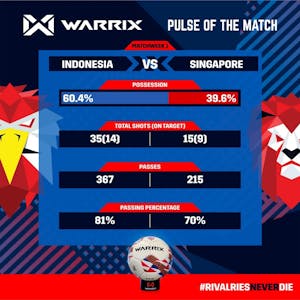Covid-19 forced the ASEAN Football Federation (AFF) into a rethink for the most recent edition of its showpiece tournament, the delayed AFF Suzuki Cup 2020.
The national team tournament is traditionally played as a series of home and away fixtures by 10 competing countries from Southeast Asia, but travel restrictions and health concerns led to the entire event being shifted to Singapore.
Originally scheduled to kick off in November 23, the event was eventually delivered from December 5, 2021, to January 1, 2022, at the Singapore National Stadium and Bishan Stadium, which operated at reduced capacities of 10,000 and 1,000 respectively.
With so few spectators permitted, organisers faced a challenge to deliver the same level of fan engagement as previous editions. As a result, a digital-first approach was adopted by the SPORTFIVE agency, which sells broadcast and sponsorship rights to the AFF Suzuki Cup.
SPORTFIVE recognised the need to step up the tournament’s content offering in both of quantity and quality, especially on social media, to maintain a connection with fans while helping sponsors and partners to achieve their marketing goals.
Project
 According to Shane Loi, digital marketing manager at SPORTFIVE Southeast Asia, the first task was to explore how to negotiate the challenges presented by pandemic-imposed restrictions to elevate the fan experience.
According to Shane Loi, digital marketing manager at SPORTFIVE Southeast Asia, the first task was to explore how to negotiate the challenges presented by pandemic-imposed restrictions to elevate the fan experience.
“When we first heard that the AFF Suzuki Cup 2020 was going to be hosted in Singapore and that there would be restrictions placed on fan attendance, we immediately started brainstorming alternative ways we could engage and interact with our regional fans in a meaningful fashion without having them physically in the stadium,” says Loi.
“We were quite clear on the direction we wanted to take – which is to be digitally forward in concept and delivery, and unique in content creation. ASEAN football is all about the fierce rivalries between nations and, with the theme of the 2020 edition being ‘Rivalries Never Die’, we wanted to create a digital campaign that fully showcased the brilliance of ASEAN football and the talented footballers while tying that to the unique brand identities of our various sponsors and partners.”
The four main objectives for the tournament were to grow the AFF Suzuki Cup fan base around the region; increase the reach of the event’s social media platforms; curate meaningful content to showcase the tournament’s unique identity and interact with fans on the various platforms; and connect sponsors with regional fans in an authentic manner.
Given the broader strategic goals, Stats Perform’s PressBox Graphics emerged as a viable platform to elevate the fan experience.
“The strategy, simply put, was to maximise the use of PressBox Graphics to help us to increase the volume and quality of our content, and to create unique story points using the wide array of data available on the platform for each of our sponsors.”
Delivery
 The availability of a wide range of quality data provided by PressBox Graphics enabled SPORTFIVE to expand its suite of branded content for sponsors and partners. These commercial affiliates were then able to build their own strategies and angles through the AFF Suzuki Cup and, accordingly, increase the relevance of their output for fans.
The availability of a wide range of quality data provided by PressBox Graphics enabled SPORTFIVE to expand its suite of branded content for sponsors and partners. These commercial affiliates were then able to build their own strategies and angles through the AFF Suzuki Cup and, accordingly, increase the relevance of their output for fans.
The automated nature of PressBox Graphics enabled SPORTFIVE to create graphics and upload them to social media easily and quickly. This significantly increased the agency’s output and productivity, while alleviating the pressure on internal staff to produce graphics manually.
The customisable nature of the graphics also enabled SPORTFIVE’s design team to be as creative as possible while sticking to the AFF Suzuki Cup brand guidelines. SPORTFIVE used PressBox Graphics for static posts across Facebook, Twitter and Instagram, while a targeted digital content plan was also formulated for TikTok and YouTube.
“Stats Perform’s data and widgets were integrated into our AFF Suzuki Cup official website as part of the ‘Stats Zone’ tab under the ‘Fan Zone’, which allowed fans to access competition stats around their favourite teams or players in real time,” says Loi. “This data was also synced to our PressBox Graphics templates where the corresponding stats would be automatically populated with the respective graphics.”
Results
 The significant increase in output of static and video content delivered a combined total of over two billion impressions and 29.5 million engagements. These were 253-per-cent and 96-per-cent increases, respectively, on the previous AFF Suzuki Cup in 2018.
The significant increase in output of static and video content delivered a combined total of over two billion impressions and 29.5 million engagements. These were 253-per-cent and 96-per-cent increases, respectively, on the previous AFF Suzuki Cup in 2018.
Static branded content created using PressBox Graphics alone generated a combined total of over 109 million impressions and 3.9 million engagements. As a result, the fan base across social media platforms increased from 2.2 million in 2018 to 3.5 million.
“We are definitely looking forward to welcoming full-capacity crowds back to the stadiums, as long as it is done in a way that ensures the safety of everyone involved,” says Loi.
“Nonetheless, adopting this digital-first approach for the AFF Suzuki Cup 2020 has allowed us to extend our reach manyfold and continue to increase our engagement with the fans, even with the restrictions imposed. With the persistence of the pandemic, as well as the evolving media landscape, we do not foresee changing our approach for the next few editions to come as we see greater potential in putting digital engagement first.
“We will be looking to work with Stats Perform and explore more avenues to tell even more compelling stories through the data that is available, and keep our fans engaged regardless of whether they can be there physically with us or not.”
Tilman Wendt, vice-president of APAC digital and brand marketing at SPORTFIVE, adds: “We have been delighted with our partnership with Stats Perform/PressBox Graphics for the AFF Suzuki Cup 2020.
“Using PressBox Graphics has opened the door to a new world of possibilities and opportunities when we are pursuing a digital-first strategy for our events. The ease and convenience in using the platform has enabled us to achieve significant efficiencies in our work and this will be crucial in today’s evolving media landscape, where consumers become decision-makers on ‘who-what-when-where-how’ they consume content.”